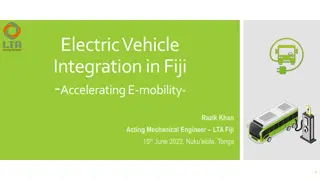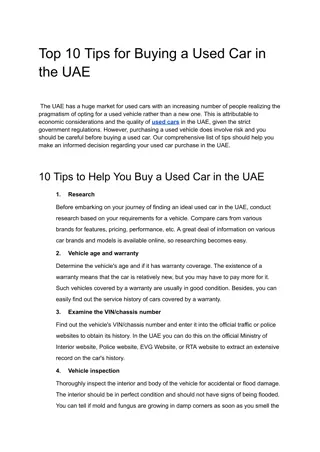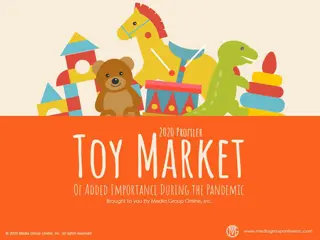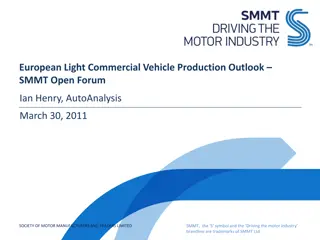Insights into Light Vehicle Buying Trends
The Media Audit's 2018 national consumer survey sheds light on the demographics of those planning to buy light vehicles: more men than women, with adults aged 25-44 being the largest group. It also discusses the preferences of working women and consumer expectations around online and onsite dealership experiences. Additionally, it highlights top-performing automotive brands in terms of customer satisfaction and advertising expenditure trends.
Download Presentation

Please find below an Image/Link to download the presentation.
The content on the website is provided AS IS for your information and personal use only. It may not be sold, licensed, or shared on other websites without obtaining consent from the author.If you encounter any issues during the download, it is possible that the publisher has removed the file from their server.
You are allowed to download the files provided on this website for personal or commercial use, subject to the condition that they are used lawfully. All files are the property of their respective owners.
The content on the website is provided AS IS for your information and personal use only. It may not be sold, licensed, or shared on other websites without obtaining consent from the author.
E N D
Presentation Transcript
Developing a Clearer Picture of Who s Buying Light-Vehicles According to The Media Audit s 2018 national consumer survey that represents approximately 40% of the US population, more men 18+ (53.3%) than women 18+ (46.7%) plan to buy a car, van, truck or SUV. Adults 25 44 are the largest age group, at 43.2%, who plan to buy a car, van, truck or SUV. The percentages are approximately the same for adults 25 44 who plan to buy a domestic or import brand. Ethnically, the largest percentage of adults 18+ who plan to buy a vehicle were Caucasian American, at 59.6%. Of all adults 18+ who plan to buy a vehicle, 23.1% were Latino Americans, and 21% plan to buy a domestic vehicle and 23.7% an import vehicle.
Attracting More Women and More Working Women Understanding working women s plans to buy a new vehicle is extremely important for dealerships. Among those 18+, 12.2% plan to buy domestic and 5.8% import. The percentages are approximately the same for working women 18 34 and 35+, although the younger group is more likely to buy a car than the older group, or 18.1% and 10.2%, respectively. The percentages don t change much for affluent working women 18+ (family income of $75K+), as just slightly more (13.5%) plan to buy a car than those planning to buy a van, truck or SUV (11.9%).
Consumers Want an Online and Onsite Dealership Experience Cox Automotive s 4 Truths of Connected Retail report reinforces consumers preference to start and do much of the buying process online, as 70% said they were likely to buy from a dealership that allows them to start online. Of those consumers participating in the report s survey, 83% want to perform one or more steps of the buying process online, with 71% saying they want information about the deal, 43% understand and secure financing and 51% structure the deal. The onsite dealership experience is still very important, however, as 80% said they would never purchase a vehicle without a test drive and 89% still want to sign the final documents at the dealership.
The Brands Achieving Customer Satisfaction The 2017 J.D. Power U.S. Sales Satisfaction Index StudySMreported Lincoln and Mercedes- Benz tied with the highest score, 830 (on a 1,000-point scale) among luxury brands, with Infiniti, 821, and Porsche, 818. Genesis had the lowest score, or 743. Among mass-market brands, Buick was first, with a score of 808; followed by MINI, 803; GMC, 793; Chevrolet, 788; and Ford, 776. Kia, at 734, and Fiat, at 707, had the lowest scores. In the 2017 J.D. Power U.S. Customer Service Index StudySM, the service advisor received the highest score from consumers, at 835; followed by service initiation, 832; vehicle pick-up, 810; service quality, 809; and service facility, 794.
Advertising Expenditures Trimmed, but Still Substantial According to the National Automobile Dealers Association (NADA) Average Dealership Profile for the first 11 months of 2017, the average dealer had a $529,087 advertising expense, 1.1% less than the first 11 months of 2016. Among the 4 dealership sub-sectors, domestic dealership spent 2.9% less; import, -4.8%; luxury, -7.9%; and mass-market, -0.3%. The advertising expense per new vehicle retailed at the average dealership decreased - 0.7%, to $633. Mass-market decreased 1.5%, to $624; domestic was unchanged at $670; but import increased +0.3%, to $613, and luxury, +5.2%, to $703.
Mobile (Read Smartphone ) Dominates Website Visits According to Dealer DataView s December 2017 report, Website visits/dealership increased 2.7% from November, to 6,691; VDP (Vehicle Detail Pages) increased 3.4% from November, to 5,719; and cost per click increased 2.0%, to $3.67. More Website visits are moving from desktop to mobile, with mobile 57% of visits, a 1% increase MOM, while desktop was the remaining 43%, a 1% decrease MOM. Smartphones dominated mobile visits at 87%, with just 13% for tablets. Only SUV VDPs increase MOM, at +1%, and had the largest percentage of visits, at 36%; followed by, sedan, 22%; truck, 21%; coupe, 5%; and other, 16%.
Advertising Strategies With almost 50% of all adults 18+ who plan to buy a vehicle having some college or one or more college degrees, dealership advertising, especially TV commercials, must present a more intelligent, measured format and message. Dealerships would also gain more traction with women and working women with messages that specifically address women s preferences when buying a vehicle. Use more women of color and women who look professional as presenters and customers in TV commercials. Dealerships would be better served with advertising, in any medium, that portray/present their sales associates as consultants/information providers, even featuring them in broadcast advertising, explaining how they consult with customers, instead of selling them.
New Media Strategies It s quite clear from the Dealer DataView data in the Profiler that dealerships Websites must be mobile-friendly and, whether desktop or mobile, navigation must be improved, according to the J.D. Power findings in the Additional Analysis section of the Profiler. Dealerships can also use their Websites (and social media) to conduct surveys to determine exactly what steps of the buying process their target audiences prefer to perform online and which they prefer to perform in the dealership. As sales associates pursue leads from Website visits, they should use those opportunities to position themselves as consultants/problem solvers, offering to answer consumer questions prior to their onsite visit to establish an excellent rapport early in the buying process.























